|
|
With Apple moving on from MacWorld after this, one blogger tried to drum up support for a no-applause response and there were people handing out "Bring back Steve Jobs" leaflets on the approach to the Moscone Center. Nice try, but an awful lot of people are convinced that MacWorld has run its course as far as Apple's new products releases are concerned, and for those of us in areas like Asia, this is a long trek, as much as I personally enjoy San Francisco. There was a moment when Phil Schiller looked a bit tense when he appeared on stage. As soon as he began it was clear that he was in charge of the day's events giving a strong and confident presentation. There were to be three new products. These may not have been as much as the mainstream wanted, and these guys don't always look betwen the lines, but some clever groundwork was laid.
This was an interesting justaposition. Last night at dinner some of the media people from S.E. Asia and some Apple personnel were discussing this and we focussed on the mystery email from Apple last year with a single image that invited the Press to and event. Within 7 days the mainstream press was in tizzy with its guessing games. The fact that one email could generate so much publicity, so easily demonstrated the brand identity and that Apple was such an innovative player that any new product was likely to have something exciting under the surface (as is seen with all three of the releases today). There are not many companies with that aura.
Faces uses face-detection to identify a person in a photograph. Images identified, can be used to create a smart album. Other photographs of that person in the library are added. Face-recognition software that identifies photographs that may be of the person already in the library and allows a user to confirm this is also used and one feature allows us to create a smart album of a family by selecting a group of faces. Places organises images according to where they were taken and includes software that uses geotagging. This links to Google maps and a map is displayed in iPhoto, complete with pins. When a specific image is highlighted, the locator pin cahnges to blue. If a photograph is not geotagged, there is a new field in Events for the location to be added by the user and iPhoto then adds a geotag. This feature in iPhoto also supports Facebook and Flickr: there are icons on the toolbar for these online services and, with Facebook for example, it is possible to synchronise with others using the service. Phil Schiller showed a couple of the new slideshow themes, which put dramatic slideshows in the reach of ordinary Mac users: much applause here. There are also new book themes, plus the new feature of including maps in a book, with pins to show a photograph's location. When he switched to demo mode, it was clear that he had done his homework. Like Jobs, he knew the product thoroughly and had clearly rehearsed. It was a smooth and professional demo. Last year's iMovie made it easier to make movies, but left many unhappy as some older features had been omitted, so much so that the older version of iMovie was made downloadable so they could both be used. Some of those missing features, particularly with regard to editing, have been added or improved. It is now possible to edit using a timeline which should never have been removed. There is advanced drag and drop of clips, several new themes are included and there are animated travel maps to show where one has been. A well-received,final feature which was video stabilisation. While a couple of these, like the maps idea are a bit glitzy and OK for kids, the rest shows some solid thinking and hard work in the labs.
There were also other features included such as adjusting the speed of the clip with no rendering time, plus additional effects, such as cartoon and aged film. Phil Schiller came back on stage to talk about Garageband which has an exceptional new feature, called, "Learn to Play". This gives a new interface of the instrument, the instructor and controls. The software comes bundled with nine basic guitar and piano lessons, however there are also Artist Lessons which can be downloaded for $4.99 each, featuring major recording artists explaining how each wrote a specific song and teaching that to the student in Garageband. Among the artists so far are John Fogarty (Proud Mary), Collie Caillat, Ryan Tedder of One Republic, Norah Jones and Sting. A couple of these lessons were played as well as the basic installation and it was an intersting dual use of technology. The new version of iLife is to be available from late January and will cost $79. As before it will also some bundled with all new Macs.
Keynote remote is a new app available for $0.99 from the App Store for the iPhone or iPod touch which allows the presentation, including a display of slides showing and to come, to be controlled from the device. As of this moment, it is not yet shown in the store. Pages has considerably more focus on use as a word processor rather than as a desktop publishing program. Several features for non-media professionals have been added, like full screen view and a dynamic outliner for control of the organisation of writing, like the chapters in a thesis. Mail Merge has been beefed up to work with Numbers, the spreadsheet software, while there is now support for Math Type and End Note integration, which will please academic writers, particularly in the science and engineering fields. Numbers has added table categories and easier formula writing including a search feature with a clear interface; there are new chart options, particularly of benefit to scientific and financial fields; and there are linked charts: if the data is changed in Numbers, a chart used in Pages, for example, will also be updated. The update to iWork is $79, with a $99 Family Pack. It is $49 with a new Mac and there is also a box set of iLife, OS X and iWork for $169. iWork is available immediately. Schiller also outlined a new service at iwork.com which allows sharing and collaboration of documents online, so that it is not necessary to use email when seeking comments. In his demo of this he used Pages, but Numbers and Keynote may also be used. It looked similar to the interface in the Mobile Me Gallery and again, one wonders how much of this is overlapping features and technology that already exist? Viewing may be in any modern browser and he mentioned Safari, Firefox and Internet Explorer. Documents can be downloaded if needed in iWork formats. Schiller told us that PDF and DOC are also available. Initially, perhaps after the disasters of Mobile Me, the service is a beta, although will later be subscription. The service came online as I was writing this. I am overloaded now so the 30-day trial and iWork itself will have to wait until I get back home.
With the slightly longer sides, there are three USB ports available. It has the same glass trackpad as the other notebooks and can handle up to 8G RAM: it comes with 4G. The standard processor is 2.66GHz although the 2.93GHz Core 2 Due os an option. There are two graphics processors like in the latest MacBook Pro 15". Other facts I saw on the slides were the weight at 6.6lbs (slightly under 3Kg); the display is 1920 x 1200 with a 700:1 contrast ratio. One of the most important new features is the lithium-polymer battery which provides up to 8 hours of life: a 60% increase. Like the installation in the MacBook Air, this is not removable by the user and has to be changed by the distributor although battery life has been considerably increase: it is now up to 1,000 cycles which is expected to be around 5 years. As Apple are using this to push their Green credentials, they have a video that Shciller showed us. This is also available online and is worth viewing as it explains the technology and engineering better than I can. Schiller did have one more thing and that was the development that soon DRM-free musci would be available on iTunes and that all the major labels had agreed to this with a 3-level price structure, $0.69, $0.99 and $1.29. Apple are going for 8m tunes immediately with another 2m to be added in the next quarter. With iTunes beginning in 2003, its almost 6 years have seen some 6 billion songs sold. There are some 75 mllion accounts all with credit cards. There is also a new feature that allows iTunes songs to be downloaded over wifi and 3G for the same price and quality. These can then sync back to iTunes on the computer when the iPhone is attached.

Those who are not yet users of Apple products (particularly iWork and iLife) are sure to miss the point. The emphasis on software services means higher future generation of income from increased use of those services. Despite the lack of galvanising products, this was a job well done by Phil Schiller.
McGuire confirmed to me that as yet there was no information on the cost of replacing that 17" MacBook Pro battery. He cited the new battery and its installation as an example of Apple's innovative technology that we can expect will trickle down to smaller devices. Of particular interest in that video was the way that a removable battery itself needs several compononents to privde that removability and by removing these, more space becomes available for the battery. A number of people were disappointed by the lack of hardware at the keynote, but this is not an accident and Apple no longer needs to rush out those products: it is on its own timetable now. Plus those additions today were concerned in part about additions to services: higher income.
|
|

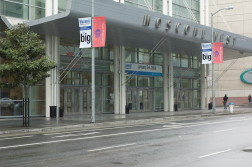 I was at the Moscone Center, West, for the Phil Schiller's keynote speech earlier.
I was at the Moscone Center, West, for the Phil Schiller's keynote speech earlier. 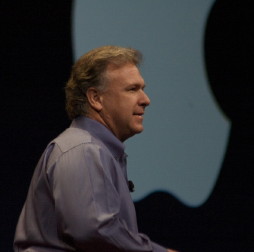 Schiller began by featuring some of the new Apple stores opened in the last twelve months, like Sydney in Australia. He suggested these highlight brand identity. With 3.4 million visits each week to these stores, that equates to 100 MacWorlds each week. Thus he justified the reasoning behind the end of Apple's involvement in MacWorld after this year.
Schiller began by featuring some of the new Apple stores opened in the last twelve months, like Sydney in Australia. He suggested these highlight brand identity. With 3.4 million visits each week to these stores, that equates to 100 MacWorlds each week. Thus he justified the reasoning behind the end of Apple's involvement in MacWorld after this year.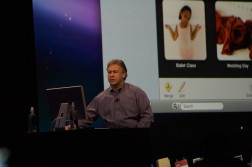 First was iLife09, with new versions of iPhoto, iMovie and Garageband, which were featured in the presentation, plus iWeb and iDVD which were in the "also ran" class. Schiller began with iPhoto09 which has some exceptional new features. To "Events" Apple adds "Faces" and "Places".
First was iLife09, with new versions of iPhoto, iMovie and Garageband, which were featured in the presentation, plus iWeb and iDVD which were in the "also ran" class. Schiller began with iPhoto09 which has some exceptional new features. To "Events" Apple adds "Faces" and "Places".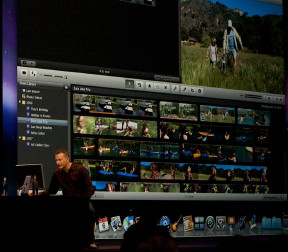 The new iMovie was demonstrated by Randy Ubillos, developer of the previous version. He showed the flexibility iMovie now has with the way it can easily edit both clips and video separately, giving a user professional capabilities with a simple interface. If anyne tried removing the audio compomnent of a clip with that last verison, it showed how hard some tasks had become and this is a necessary change. When he showed how a shot from a moving jeep could be stabilised, thus enhancing the images filmed, there was considerable appreciation. He had some film of gazelles which were really difficult to see because of the jeep's motion. When the effect was applied, it was almost as if some highlighting to the gazelles had taken place: what was invisible was now higlighted.
The new iMovie was demonstrated by Randy Ubillos, developer of the previous version. He showed the flexibility iMovie now has with the way it can easily edit both clips and video separately, giving a user professional capabilities with a simple interface. If anyne tried removing the audio compomnent of a clip with that last verison, it showed how hard some tasks had become and this is a necessary change. When he showed how a shot from a moving jeep could be stabilised, thus enhancing the images filmed, there was considerable appreciation. He had some film of gazelles which were really difficult to see because of the jeep's motion. When the effect was applied, it was almost as if some highlighting to the gazelles had taken place: what was invisible was now higlighted.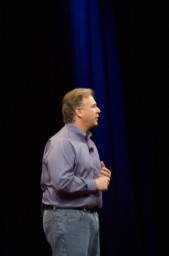
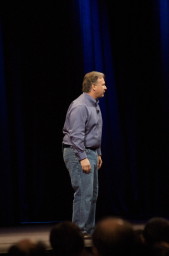
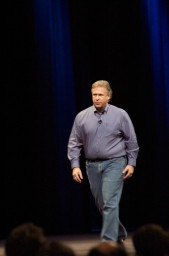
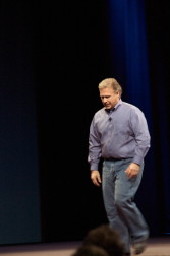
 Outside the hall itself we were introduced to Mike McGuire, Vice-President for Media Indstry Advisory Services [of Gartner] who talked about some of the points that had come up. He empasised that the move away from MacWorld was a move away from a specific new year date for product announcements to times which gave Apple more flexibility, or a better access to market timing (such as products for the back to school period). An example might be the lack of any announcement about OS X, 10.6, Snow Leopard.
Outside the hall itself we were introduced to Mike McGuire, Vice-President for Media Indstry Advisory Services [of Gartner] who talked about some of the points that had come up. He empasised that the move away from MacWorld was a move away from a specific new year date for product announcements to times which gave Apple more flexibility, or a better access to market timing (such as products for the back to school period). An example might be the lack of any announcement about OS X, 10.6, Snow Leopard.